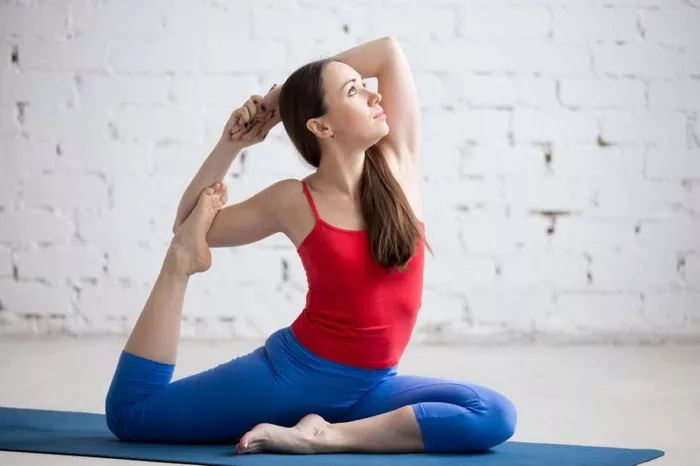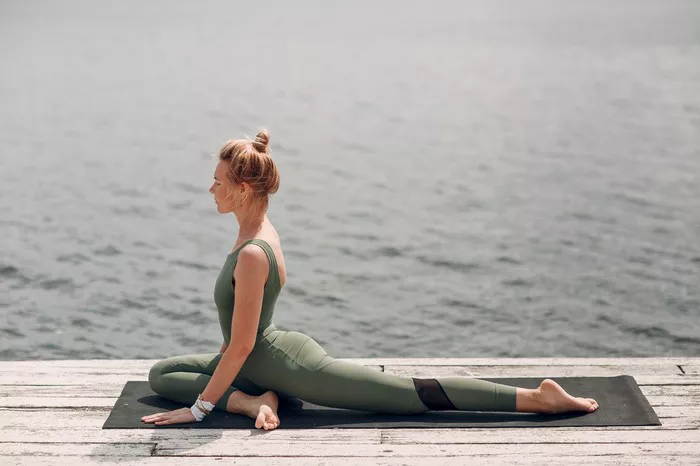Yoga is a powerful practice that promotes physical health, mental clarity, and emotional well-being. For centuries, people across the world have practiced yoga to cultivate a deeper connection between the body, mind, and spirit. One of the essential aspects of yoga is the variety of poses, or “asanas,” that can be performed. Each pose targets different muscle groups and has unique benefits for the practitioner.
In this article, we will explore the different types of yoga poses, explain their benefits, and provide a simple guide to understanding how they can improve your overall wellness. Whether you’re a beginner or an experienced practitioner, learning about these poses can help you enhance your practice and bring more balance into your life.
Understanding Yoga Poses
Yoga poses are designed to stretch, strengthen, and balance the body. They are often combined with controlled breathing to help practitioners deepen their awareness and concentration. These poses can be broadly categorized into several types, including standing poses, seated poses, backbends, inversions, twists, and restorative poses. Each type serves a different purpose and offers a unique benefit to your health.
1. Standing Poses
Standing poses are some of the most fundamental yoga postures. They help build strength, improve balance, and increase flexibility. These poses also activate the legs, hips, and core muscles. Standing poses often form the foundation of many yoga flows and are commonly practiced in styles like Vinyasa and Hatha yoga.
Key Standing Poses:
Mountain Pose (Tadasana): This is the foundation for many other poses. While it may look simple, Mountain Pose helps improve posture, lengthens the spine, and increases overall body awareness. It also engages the thighs, core, and arms, and promotes balance and stability.
Warrior I (Virabhadrasana I): Warrior I is a strong standing pose that strengthens the legs, opens the hips, and stretches the arms. This pose enhances stability and endurance and is excellent for improving posture and promoting physical energy.
Warrior II (Virabhadrasana II): In this variation, the arms are extended to the sides, and the hips are squared. Warrior II helps improve flexibility in the hips and thighs, strengthens the legs, and opens the chest and shoulders. It’s also great for building endurance.
Triangle Pose (Trikonasana): Triangle pose stretches the legs, hips, and sides of the torso while strengthening the core and legs. It also improves balance and promotes deep breathing. This pose is excellent for improving flexibility in the hamstrings and hips.
Extended Side Angle Pose (Utthita Parsvakonasana): This pose involves bending the front knee while keeping the legs active, stretching the side body, and extending the arms. It helps open the chest, stretch the hips, and improve balance.
2. Seated Poses
Seated poses are typically focused on flexibility, relaxation, and mindfulness. These poses are ideal for calming the mind, increasing mobility in the hips, and opening the lower body. Seated postures are often included in styles such as Yin Yoga and Restorative Yoga, as well as in traditional meditation practices.
Key Seated Poses:
Easy Pose (Sukhasana): Easy Pose is a simple seated posture where the legs are crossed in front of the body. This is a common meditation pose that encourages calmness and focus. It stretches the knees, hips, and lower back and helps promote good posture.
Seated Forward Fold (Paschimottanasana): This forward fold stretches the hamstrings, calves, and lower back. It can help calm the nervous system, relieve stress, and improve flexibility in the legs and spine.
Bound Angle Pose (Baddha Konasana): In Bound Angle Pose, the soles of the feet are brought together, and the knees are bent outward. This pose is great for stretching the inner thighs, hips, and groin. It also promotes relaxation and can help improve flexibility over time.
Hero Pose (Virasana): Hero Pose is performed by sitting on the floor with the legs bent behind you, the thighs and knees together, and the feet tucked beneath the hips. This pose is excellent for stretching the thighs, knees, and ankles, while also encouraging good posture.
3. Backbends
Backbends are an important category of yoga poses that help open the chest, increase spinal flexibility, and strengthen the back muscles. These poses are great for counteracting the effects of sitting and slouching, which can cause stiffness in the spine and shoulders. Backbends also help improve posture, energy flow, and breath capacity.
Key Backbends:
Cobra Pose (Bhujangasana): Cobra Pose is a gentle backbend that stretches the chest, shoulders, and abdomen. It strengthens the lower back muscles and can help relieve tension in the spine. This pose is often used in Vinyasa and Hatha Yoga sequences.
Bridge Pose (Setu Bandhasana): In Bridge Pose, the hips are lifted off the floor while the arms and feet remain grounded. This backbend strengthens the glutes, legs, and lower back while opening the chest and improving spinal flexibility.
Camel Pose (Ustrasana): Camel Pose is a deep backbend that stretches the chest, hips, and front body. It improves spinal flexibility and helps open the heart chakra. It is considered an intense backbend and should be practiced with care.
Wheel Pose (Chakrasana): Wheel Pose is an advanced backbend that requires significant flexibility and strength. It opens up the entire front body, from the chest to the thighs, and stretches the spine deeply. This pose also strengthens the arms, core, and legs.
4. Inversions
Inversions involve turning the body upside down, where the head is lower than the heart. These poses can increase circulation, improve balance, and provide a new perspective on the world. Inversions are energizing, but they should be practiced with care to avoid strain or injury.
Key Inversions:
Downward-Facing Dog (Adho Mukha Svanasana): This is a foundational inversion where the body forms an inverted “V” shape. It stretches the hamstrings, calves, and shoulders while strengthening the arms, legs, and core. It is often practiced in Vinyasa flows.
Shoulder Stand (Sarvangasana): In Shoulder Stand, the body is inverted with the weight resting on the shoulders and the legs extended vertically. This pose improves circulation, strengthens the shoulders and arms, and stimulates the thyroid and metabolism. It’s often called the “queen” of all asanas.
Headstand (Sirsasana): Headstand is an advanced inversion that involves balancing on the head with the legs extended vertically. It strengthens the shoulders, arms, and core, improves balance, and increases circulation to the brain. It should only be attempted once a practitioner has developed adequate strength and alignment.
Plow Pose (Halasana): Plow Pose is an inversion that involves bringing the legs over the head to touch the floor behind the body. This pose stretches the shoulders, spine, and hamstrings and can promote relaxation and mental clarity.
5. Twists
Twisting poses are excellent for improving spinal mobility, enhancing digestion, and stretching the muscles of the back and abdomen. They help release tension in the spine and promote detoxification by stimulating the digestive organs.
Key Twists:
Seated Spinal Twist (Ardha Matsyendrasana): This seated pose involves twisting the spine while keeping the legs crossed. It stretches the back, shoulders, and hips and improves spinal flexibility. It’s particularly beneficial for digestion and detoxification.
Revolved Triangle Pose (Parivrtta Trikonasana): This standing twist involves a deep twist of the torso while the legs are in a triangle shape. It strengthens the legs, stretches the hips and spine, and encourages deep rotation in the torso.
Supine Twist (Supta Matsyendrasana): This twist is performed while lying on the back, bringing one leg across the body. It gently stretches the back and helps relieve lower back pain and tension.
See Also: What Are the Different Types of Yoga Asanas?
6. Restorative Poses
Restorative yoga poses are focused on relaxation and stress relief. These poses are typically done in a supported manner, using props like blankets, blocks, and bolsters to create comfort and ease. Restorative poses are perfect for relieving tension and allowing the body to fully relax and restore.
Key Restorative Poses:
Child’s Pose (Balasana): Child’s Pose is a deeply restorative pose that encourages relaxation and calm. It stretches the back, hips, and thighs, and is often used as a resting posture in between more intense poses. It helps reduce stress and anxiety.
Legs Up the Wall (Viparita Karani): In this restorative inversion, the legs are extended up a wall while lying on the back. This pose is very calming and helps relieve tension in the legs, hips, and lower back. It is often used to relax after a long day or during a restorative yoga practice.
Savasana (Corpse Pose): Savasana is the final resting pose at the end of most yoga practices. It involves lying flat on the back with the eyes closed and the body fully relaxed. Savasana allows the body to integrate the benefits of the practice and promotes deep relaxation.
Conclusion
Yoga is a deeply versatile practice, and the different types of yoga poses offer a wide range of benefits to suit different needs and goals. Whether you are looking to build strength, improve flexibility, relieve stress, or calm the mind, there is a pose for every purpose. By understanding and practicing these various poses, you can develop a balanced and holistic yoga practice that nurtures your body, mind, and spirit. So, find the poses that resonate with you, and enjoy the journey of self-discovery and wellness through yoga.
You Might Be Interested In





















